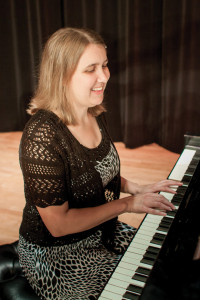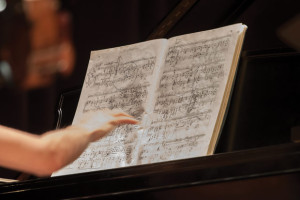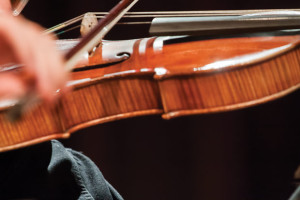By Joan Tupponce

When John started music therapy last July at the Sentara Music and Medicine Center in Norfolk, Bowdish wasted no time. She began teaching John how to bring some of his speech back by tapping his left hand and humming to the phrase, “Hello my name is John.” When she finished, he would hum the tune. Bowdish would then sing the same phrase, and John would repeat it. “Then she would say it, and he would repeat it,” says Trina. “He can say ‘My name is John’ to this day.”
Later, John would learn more difficult phrases: “I need to go to the bathroom,” “I am going to ride my bike,” and the date of his birthday. “She did all this by tapping his hand and fading from singing to speech,” says Trina. “I was in awe of her.” Though the couple had been to several doctors, no one had been able to explain the connection between the stroke and John’s brain the way Bowdish did—in layman’s terms—making sure, says Trina, that “I knew how to implement music therapy at home.”
Thankfully, some of John’s speech is coming back. “He is beginning to get words out more quickly now,” says Trina, “and his vocabulary has picked up.”

“Studies show that live music is superior to recorded music in bringing effect to disease and pain,” says Chemali. A conservatory-trained pianist who also performs for his patients, Chemali understands on both personal and professional levels that music produces physiological as well as psychological benefits. He began organizing concerts for patients during medical school at the Lebanese University of Medical Sciences in Beirut and then, as a resident, he used music to help patients overcome depression and schizophrenia. “I noticed how it would cheer them up,” he explains. “I was fascinated with how music affects us.”
Chemali later founded the Arts & Medicine Institute at Cleveland Clinic after spending 15 years researching the healing effects of music. He found that approximately 70 percent of the patients he surveyed experienced overwhelmingly positive improvements when they were exposed to music. When Chemali first came to Sentara in 2010 and created the center, it became one of just a few such centers in the U.S., joining Cleveland Clinic in Ohio, and Beth Israel Medical Center and Sloan Kettering in New York.
Music is the “tool” that neurologic music therapists like Bowdish use to help people like John Stout gain or regain executive skills such as organization and decision making that have been impaired due to a stroke or a traumatic accident. (It was music therapy that helped Congresswoman Gabrielle Giffords regain her speech after a gunshot wound to her head left her critically injured.)
“When you use music, you are more apt to remember,” explains Bowdish, who earned her bachelor’s degree in music from Concordia College in Moorhead, Minnesota, and obtained her master’s degree in music therapy from Western Michigan University. Factual information like birthdays, phone numbers or steps to a favorite hobby can be put into a song. “Whatever information is meaningful to them,” she says. “The song will help them retrieve that information.”
During melodic intonation therapy—the primary technique Bowdish used with John Stout—she first teaches her patients to sing words to melodies, then she gradually phases out the music. “When we sing we use more of our brains than when we speak because music has more than language. It has melody, rhythm, meter and emotion. There are patterns involved when we sing. We need to use additional neural networks or pathways,” she says. “That is why someone who has had a stroke that affects speech can still sing.”

Sally Paul of Norfolk knows how frustrated her 30-year-old son, Phillip Safrans, gets when he tries to recognize people or make a decision. Safrans has been having strokes since he was 14. In 2012, he suffered a large stroke and lost his memory and his speech. “He couldn’t read anymore, and he couldn’t make decisions,” Paul says, adding that he also had trouble remembering how to get home or to other specific destinations.
During his sessions with Bowdish, Safrans would pick a song he liked and Bowdish would sing it. After several lines, she would stop and analyze the words with him. “At one point, he wrote a song to his sister. He put the words together, and Tracy [Bowdish] helped him pick the beats and the rhythm,” Paul says.
During one session, after listening to the song “Life is a Highway” by Tom Cochrane, Safrans started talking about how he felt after his stroke in 2012. “One day he didn’t have a care in the world and—boom, overnight—he couldn’t do anything,” Paul says. “He was relaying all that about his life because it related to the song. That made me cry.”
Music therapy has also helped Safrans regain some of his memory, giving him the ability to do things like drive his car to his sister’s house in Florida and ride the train home by himself. “It’s little things like that,” Paul says of his advances. “Music therapy has really helped him.”
Music’s healing properties have long been recognized, since the days of Aristotle, according to the American Music Therapy Association. Music can help alleviate pain, lessen muscle tension, spur relaxation and modify moods.
“There is not a magical type of music that will make us relax or feel better. If you want to increase your ability to relax and decrease anxiety, it’s going to involve my working with you to determine preferences, as well as the unique way you respond to various types and tempos of music,” says Bowdish. Music therapy can be used with Alzheimer’s patients to bring back positive memories and, in some group psychotherapy sessions, to “help people open up and express themselves,” she says.
The benefits of neurologic music therapy also extend to people who have movement disorders caused by a brain injury, stroke or Parkinson’s disease. Says Bowdish: “We use rhythm to help cue and optimize movement. Rhythm provides timing cues so our brain can tell our muscles how much time we have to execute a specific motion.” Certain tempos are used in a technique called rhythmic auditory stimulation. “I use rhythm based on somebody’s steps per minute,” Bowdish says. For example, a person who walks 60 steps per minute will be asked to walk to music that is 60 beats per minute. “The body will synchronize to this. I have seen patients who have had strokes make significant gains in their ability to walk.”
Greg Crockett, 49, of Suffolk, worked with Bowdish after he suffered a sudden stroke that affected his ability to walk at a normal pace. During therapy he was required to walk to a different tempo each week. “After each tempo, I would walk faster,” he says, noting that he went to therapy for approximately four months and found that it also helped his balance and gait.
Crockett says his therapist used a variety of musical genres during the process. “It wasn’t one type of music; it was more about the beat.”
Today Crockett is walking much faster than he was before he began his sessions.
“It’s not breakneck speed, but my little girl doesn’t have to wait for me as much as she did,” says Crockett, surprised by his progress. “It amazes me.”
